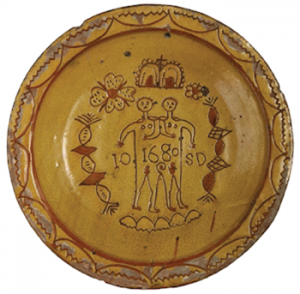
If you have ever travelled along the snaking lanes that connect the two villages of Donyatt and Horton, you will be forgiven for not noticing anything other than agricultural land and a peppering of dwellings. Admittedly, there are also several extensive renovations taking place in the area, making good use of derelict outbuildings. However, enquire into the surroundings and you will discover an almost forgotten history. The two tarmacked routes that lead to the area (known as Witney Bottom) are accessed from both Pottery Road and Crock Street.
Furthermore, for the eagle-eyed observer, there exists a thatched, circular clay puddling house situated behind a property undergoing a much-needed facelift. If the linkage is not yet obvious, then what is underneath your feet, tyres, or hoofs will reveal all. For centuries, this area was of geological importance, providing a consecutive community of artisanal potters with Liassic clay.
Donyatt potteries had existed on the land since the 12th century, producing an extensive and eclectic mix of carefully handcrafted items. It is believed that the land was home to nineteen pottery sites spread across seven fields. Operating throughout multiple epochs, the wares became a microcosmic reflection of society. One such example, which survives to this day and can be viewed at the Museum of Somerset, in Taunton, is a plate designed in the potters’ distinctive sgraffito style. It celebrated the remarkable birth of the Isle Brewers’ Siamese twins of 1680, who, by contrast in pamphlets, were branded as a ‘monstrosity’ and viewed with superstition. The twins, named Priscilla and Aquila, are depicted in the central well of the plate, accompanied by a magisterial crown and floral decorations.
Nevertheless, the majority of Donyatt’s wares were not commemorative. Instead, they were designed for regular usage for all echelons of society. The list was endless: chimney pots, smoking pipes, candlesticks, flowerpots, jugs, roof tiles, chamber pots and bottles. The pieces that still exist today provide an insightful indication of what local life was like at the time—fuddling cups are a quirky reflection of this. These delightful artefacts, consisting of three to six interlaced cups, would once have been the allurement of the alehouses. For the frequenting drinker of cider, the challenge would be to guzzle the contents of each cup without any spillage.
Much of the ochre-terracotta coloured, glazed goods were destined for the local markets that took place in relatively larger towns of the countryside. Unsurprisingly, Taunton was a major destination, of which Donyatt potteries satisfied 95% of the ceramic requirements during the early modern period. According to reports, other markets took place further afield in Cerne Abbas, Ilchester and Axbridge. However, by the 17th and 18th centuries, national changes began to disseminate to rural villages. Incremental industrialising processes yielded an advantage for Donyatt. With the advent of exportation methods that spanned a much larger distance than managed by the humble horse and cart, Donyatt’s treasured goods could now be sold from Bristol, Southampton, London and Ireland. The Thirteen Colonies became an international marketplace, with pieces still in existence today in Virginia and Maryland.
While industrialisation was a benefit to exportation, it proved a hindrance to Donyatt’s longevity. In the 18th Century, ceramic goods sent to Taunton had fallen dramatically to 30%.
Furthermore, as was experienced across Europe, urbanisation displaced agrarian workers from the countryside. The opportunity for better living conditions, employment stability and improved public health limited the appeal of the increasingly remote conditions of Donyatt. Artisanal pottery was also stifled from the operations of larger, commercial businesses. The advanced firing of clay with coal proved more efficient, unlike Donyatt’s usage of wood. Additionally, potters were likely to be farmers and any craftmanship was to be part-time. The irregularity of production and trade was sure to have a long-term impact.
By the 20th Century, the potters’ conservative style continued to be propagated within the small nature of the business from generation to generation. To achieve this, a degree of formality ensued with the employment of young apprentices, who were contracted for eight years to acquire the specialist knowledge which had been practised at Donyatt for centuries. A typical working week would involve eleven-hour days Monday to Thursday, six hours on a Friday and a weekend day responsibility, all for eight shillings per week. Among the last recorded occupants of Donyatt potteries is the Arlidge family, who were resident during the 1930s. Alongside creating ceramic wares, William Arlidge, an established potter at Donyatt, ran a shop in Taunton’s East Reach.
Although success ebbed and flowed, the traumatic years of 1939-1945 proved unviable for Donyatt potteries, and by 1942, it ceased to exist. Many of the former potters returned to work on farmland, such as local lad Charles Anning. Yet, memories of the potteries remained evocative. Anning, of nearby Horton, gave an interview in the late 20th Century, describing how at the age of fourteen he began working for the potteries, was trained on a potter’s wheel, dug for the infamous Liassic clay and produced wares from moulds.
Donyatt potteries are puzzling; it experienced a lengthy history, but an almost instantaneous disappearance. Excavations in the 1970s proved fruitful in confirming the existence of the community and the unearthing of multiple fragments of pottery. Today, while the people and buildings are no longer present, pieces of whole pottery still are and provide a lasting trace back to this enigmatic enterprise.
With many thanks to Jim Sainsbury from the Heritage of the Ile Trust for the photographs, and to the writers of ‘The Story of Donyatt and Millennium Celebrations’ book for a useful reference guide.




